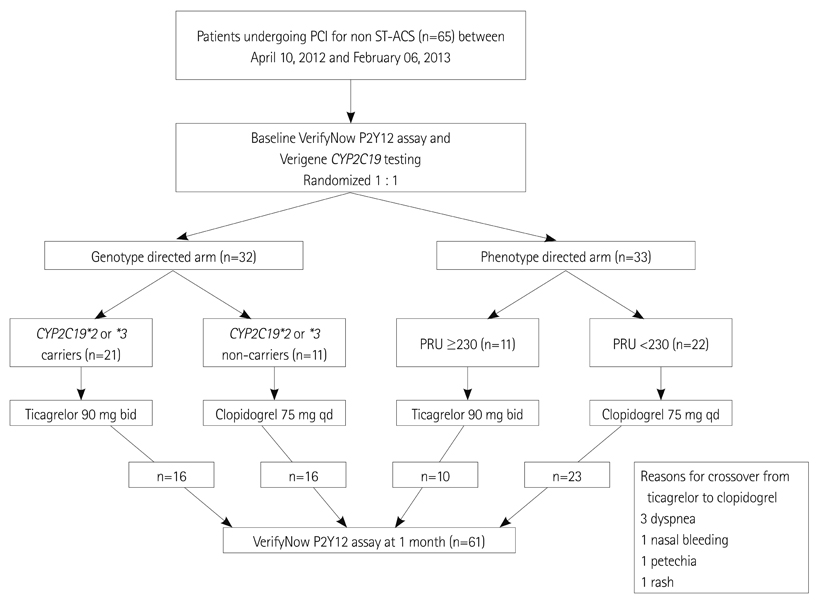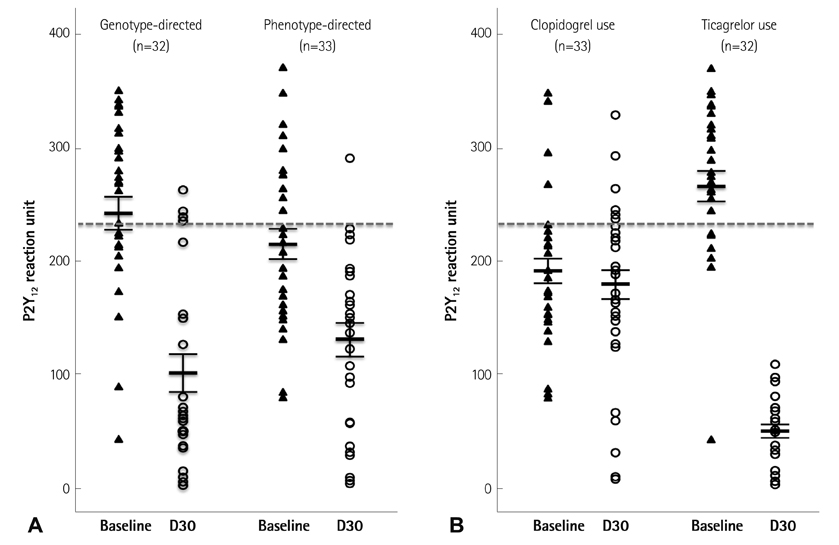Korean Circ J.
2013 Aug;43(8):541-549. 10.4070/kcj.2013.43.8.541.
Genotype- and Phenotype-Directed Personalization of Antiplatelet Treatment in Patients with Non-ST Elevation Acute Coronary Syndromes Undergoing Coronary Stenting
- Affiliations
-
- 1Division of Cardiology, Yonsei University Wonju College of Medicine, Wonju, Korea. jyoon@yonsei.ac.kr
- 2Department of Laboratory Medicine, Yonsei University Wonju College of Medicine, Wonju, Korea.
- 3Department of Cardiology, Ajou University Medical Center, Suwon, Korea.
- KMID: 2224844
- DOI: http://doi.org/10.4070/kcj.2013.43.8.541
Abstract
- BACKGROUND AND OBJECTIVES
We evaluated the effectiveness of genotype- and phenotype-directed individualization of P2Y12 inhibitors to decrease high on-treatment platelet reactivity (HOPR).
SUBJECTS AND METHODS
Sixty-five patients undergoing percutaneous coronary intervention for non-ST elevation acute coronary syndromes were randomly assigned to genotype- or phenotype-directed treatment. All patients were screened for CYP2C19*2, *3, or *17 alleles by using the Verigene CLO assay (Nanosphere, Northbrook, IL, USA). The P2Y12 reaction unit (PRU) was measured using the VerifyNow P2Y12 assay (Accumetrics, San Diego, CA, USA). 21 CYP2C19 *2 or *3 carriers (65.6%) and 11 patients with HOPR (33.3%), defined as a PRU value > or =230, were given 90 mg ticagrelor twice daily; non-carriers and patients without HOPR were given 75 mg clopidogrel daily. The primary endpoint was the percentage of patients with HOPR after 30 days of treatment.
RESULTS
PRU decreased following both genotype- and phenotype-directed therapies (242+/-83 vs. 109+/-90, p<0.001 in the genotype-directed group; 216+/-74 vs. 109+/-90, p=0.001 in the phenotype-directed group). Five subjects (16.2%) in the genotype-directed group and one (3.3%) in the phenotype-directed group had HOPR at day 30 (p=0.086). All patients with HOPR at the baseline who received ticagrelor had a PRU value of <230 after 30 days of treatment. Conversely, clopidogrel did not lower the number of patients with HOPR at the baseline.
CONCLUSION
Tailored antiplatelet therapy according to point-of-care genetic and phenotypic testing may be effective in decreasing HOPR after 30 days.
MeSH Terms
Figure
Reference
-
1. Yusuf S, Zhao F, Mehta SR, et al. Effects of clopidogrel in addition to aspirin in patients with acute coronary syndromes without ST-segment elevation. N Engl J Med. 2001; 345:494–502.2. Levine GN, Bates ER, Blankenship JC, et al. 2011 ACCF/AHA/SCAI Guideline for Percutaneous Coronary Intervention: executive summary: a report of the American College of Cardiology Foundation/American Heart Association Task Force on Practice Guidelines and the Society for Cardiovascular Angiography and Interventions. Circulation. 2011; 124:2574–2609.3. Tang EW, Wong CK, Herbison P. Global Registry of Acute Coronary Events (GRACE) hospital discharge risk score accurately predicts long-term mortality post acute coronary syndrome. Am Heart J. 2007; 153:29–35.4. Ahn SG, Lee SH, Yoon JH, et al. Different prognostic significance of high on-treatment platelet reactivity as assessed by the VerifyNow P2Y12 assay after coronary stenting in patients with and without acute myocardial infarction. JACC Cardiovasc Interv. 2012; 5:259–267.5. Marcucci R, Gori AM, Paniccia R, et al. Cardiovascular death and nonfatal myocardial infarction in acute coronary syndrome patients receiving coronary stenting are predicted by residual platelet reactivity to ADP detected by a point-of-care assay: a 12-month follow-up. Circulation. 2009; 119:237–242.6. Lee K, Lee SW, Lee JW, et al. The significance of clopidogrel low-responsiveness on stent thrombosis and cardiac death assessed by the verifynow p(2)y(12) assay in patients with acute coronary syndrome within 6 months after drug-eluting stent implantation. Korean Circ J. 2009; 39:512–518.7. Wiviott SD, Braunwald E, McCabe CH, et al. Prasugrel versus clopidogrel in patients with acute coronary syndromes. N Engl J Med. 2007; 357:2001–2015.8. Wallentin L, Becker RC, Budaj A, et al. Ticagrelor versus clopidogrel in patients with acute coronary syndromes. N Engl J Med. 2009; 361:1045–1057.9. Patti G, Nusca A, Mangiacapra F, Gatto L, D'Ambrosio A, Di Sciascio G. Point-of-care measurement of clopidogrel responsiveness predicts clinical outcome in patients undergoing percutaneous coronary intervention results of the ARMYDA-PRO (Antiplatelet therapy for Reduction of MYocardial Damage during Angioplasty-Platelet Reactivity Predicts Outcome) study. J Am Coll Cardiol. 2008; 52:1128–1133.10. Price MJ, Berger PB, Teirstein PS, et al. Standard- vs high-dose clopidogrel based on platelet function testing after percutaneous coronary intervention: the GRAVITAS randomized trial. JAMA. 2011; 305:1097–1105.11. Price MJ. Bedside evaluation of thienopyridine antiplatelet therapy. Circulation. 2009; 119:2625–2632.12. Buchan BW, Peterson JF, Cogbill CH, et al. Evaluation of a microarray-based genotyping assay for the rapid detection of cytochrome P450 2C19 *2 and *3 polymorphisms from whole blood using nanoparticle probes. Am J Clin Pathol. 2011; 136:604–608.13. Trenk D, Stone GW, Gawaz M, et al. A randomized trial of prasugrel versus clopidogrel in patients with high platelet reactivity on clopidogrel after elective percutaneous coronary intervention with implantation of drug-eluting stents: results of the TRIGGER-PCI (Testing Platelet Reactivity In Patients Undergoing Elective Stent Placement on Clopidogrel to Guide Alternative Therapy With Prasugrel) study. J Am Coll Cardiol. 2012; 59:2159–2164.14. Roberts JD, Wells GA, Le May MR, et al. Point-of-care genetic testing for personalisation of antiplatelet treatment (RAPID GENE): a prospective, randomised, proof-of-concept trial. Lancet. 2012; 379:1705–1711.15. Bonello L, Tantry US, Marcucci R, et al. Consensus and future directions on the definition of high on-treatment platelet reactivity to adenosine diphosphate. J Am Coll Cardiol. 2010; 56:919–933.16. Ko YG, Suh JW, Kim BH, et al. Comparison of 2 point-of-care platelet function tests, VerifyNow Assay and Multiple Electrode Platelet Aggregometry, for predicting early clinical outcomes in patients undergoing percutaneous coronary intervention. Am Heart J. 2011; 161:383–390.17. Park KW, Park JJ, Jeon KH, et al. Clinical predictors of high posttreatment platelet reactivity to clopidogrel in Koreans. Cardiovasc Ther. 2012; 30:5–11.18. Jannetto PJ, Buchan BW, Vaughan KA, et al. Real-time detection of influenza a, influenza B, and respiratory syncytial virus a and B in respiratory specimens by use of nanoparticle probes. J Clin Microbiol. 2010; 48:3997–4002.19. Saracini C, Vestrini A, Galora S, Armillis A, Abbate R, Giusti B. Pharmacogenetics of clopidogrel: comparison between a standard and a rapid genetic testing. Genet Test Mol Biomarkers. 2012; 16:500–503.20. Mehran R, Rao SV, Bhatt DL, et al. Standardized bleeding definitions for cardiovascular clinical trials: a consensus report from the Bleeding Academic Research Consortium. Circulation. 2011; 123:2736–2747.21. Mehta SR, Tanguay JF, Eikelboom JW, et al. Double-dose versus standard-dose clopidogrel and high-dose versus low-dose aspirin in individuals undergoing percutaneous coronary intervention for acute coronary syndromes (CURRENT-OASIS 7): a randomised factorial trial. Lancet. 2010; 376:1233–1243.22. Chen KY, Rha SW, Li YJ, et al. Triple versus dual antiplatelet therapy in patients with acute ST-segment elevation myocardial infarction undergoing primary percutaneous coronary intervention. Circulation. 2009; 119:3207–3214.23. Suh JW, Lee SP, Park KW, et al. Multicenter randomized trial evaluating the efficacy of cilostazol on ischemic vascular complications after drug-eluting stent implantation for coronary heart disease: results of the CILON-T (influence of CILostazol-based triple antiplatelet therapy ON ischemic complication after drug-eluting stenT implantation) trial. J Am Coll Cardiol. 2011; 57:280–289.24. Eikelboom JW, Mehta SR, Anand SS, Xie C, Fox KA, Yusuf S. Adverse impact of bleeding on prognosis in patients with acute coronary syndromes. Circulation. 2006; 114:774–782.25. Campo G, Parrinello G, Ferraresi P, et al. Prospective evaluation of onclopidogrel platelet reactivity over time in patients treated with percutaneous coronary intervention relationship with gene polymorphisms and clinical outcome. J Am Coll Cardiol. 2011; 57:2474–2483.26. Ahn SG, Lee SH, Sung JK, Kim JY, Yoon J. Intra-individual variability of residual platelet reactivity assessed by the VerifyNow-P2Y12 assay in patients with clopidogrel resistance after percutaneous coronary intervention. Platelets. 2011; 22:305–307.27. Collet JP, Cuisset T, Rangé G, et al. Bedside monitoring to adjust antiplatelet therapy for coronary stenting. N Engl J Med. 2012; 367:2100–2109.28. Shuldiner AR, O'Connell JR, Bliden KP, et al. Association of cytochrome P450 2C19 genotype with the antiplatelet effect and clinical efficacy of clopidogrel therapy. JAMA. 2009; 302:849–857.29. Mega JL, Hochholzer W, Frelinger AL 3rd, et al. Dosing clopidogrel based on CYP2C19 genotype and the effect on platelet reactivity in patients with stable cardiovascular disease. JAMA. 2011; 306:2221–2228.
- Full Text Links
- Actions
-
Cited
- CITED
-
- Close
- Share
- Similar articles
-
- De-escalation strategies of dual antiplatelet therapy in patients undergoing percutaneous coronary intervention for acute coronary syndrome
- Successful Primary Percutaneous Coronary Intervention without Stenting: Insight from Optimal Coherence Tomography
- Updates in the management of patients with acute coronary syndrome
- Perioperative management for patients undergoing noncardiac surgery after percutaneous coronary intervention
- Updates in the Management of Coronary Artery Disease



